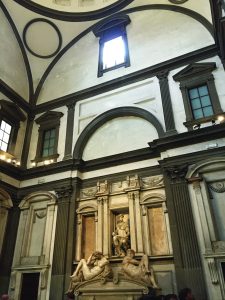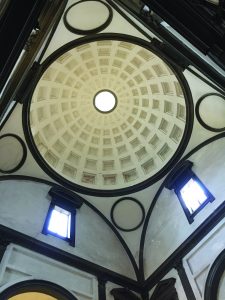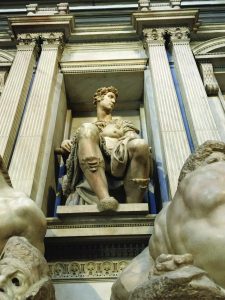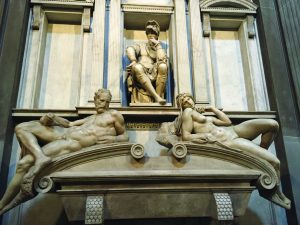The Pope commissioned Michelangelo to build a new burial chamber for his family on the San Lorenzo church

The Medici Chapels in Florence is a fascinating complex. It is entirely planned both architecturally and sculpturally by Michelangelo, whose own life was so intertwined with the Medici family. When he was commissioned the project by Pope Leone X (Giovanni de’ Medici) in 1519, both he and the Pope were in their mid-40s and they knew each other well.
They had been born in the same year and had lived under the same roof for a few years as adolescents. Michelangelo had been invited to live with the Medici family in their palatial Renaissance merchant home opposite the San Lorenzo church, where the Medici chapels would be built decades later, when he was 15. Lorenzo the Magnificent, the future pope’s father, was the head of the family at that time and the Medici family were the unofficial rulers of the Republic of Florence.
The Pope commissioned Michelangelo to build an annex structure on the San Lorenzo church which was intended to be a new burial chamber for his family. The location was in direct line with the high altar on the opposite axis to the church’s sacristy. Michelangelo’s project was thus dubbed the ‘New Sacristy’, or the ‘Medici Chapels’.

One hundred years before Michelangelo began the Medici chapels, the Medici had been one of the instigating families who launched the complete rebuilding of the San Lorenzo church. Other than making sure that their personal family chapel was in one of the best locations (at the end of one of the transepts), they also paid for the patronage of the sacristy, one of the most sacred places of a church.
Filippo Brunelleschi, the first Renaissance architect and inventor of mathematical perspective, was the architect and mastermind behind San Lorenzo, one of the first projected Renaissance spaces.
The Sacristy of San Lorenzo is a synthesis of the principles of Renaissance philosophy, represented in the co-existence of the perfect shapes seen in the floor plan (square) and ceiling (circle) and the use of simple measurements which together create a balanced and harmonious structure. The motivation behind this priority given to harmony and balance was to structurally represent the new belief that man is the measure of all things and the new optimismin the capacity of humankind. The control in the architecture reflects the control that man has in his life. Brunelleschi was two generations before Michelangelo.
Michelangelo deliberately used Brunelleschi’s sacristy as a model whilst, at the same, time making some major changes.
When Michelangelo was living with the Medici family as a teenager, he trained in sculpture during the day in a Medici-funded sculpture workshop/school in one of the family’s gardens located in the area of San Marco church; and then in the evenings he stayed at the Medici home, being granted a fixed place at the table for meals. This tells us that he was treated like a child of Lorenzo, the patriarch of the family. Lorenzo recognised the young Florentine’s talent and genius and ensured that he received instruction and training to best realise his potential.
It was during these unbelievably formative years, under the tutelage of the Medici, who exposed him to the conversations and discourses held at their home by some of the most important theologians and philosophers of the day, that he began to develop his own spiritual expression, which he channelled through the sculptural process into the finished work.

Michelangelo was the first artisan/artist to consider his sculpture as expressions of his God-given talent and thus they become for him visual prayers. He digested the conversations from the Medici home and translated them into his personal experience. He constantly and persistently nourished, what he considered, was his blessed talent. His inner talent controlled his bestial body matter, training it to produce beauty which had its roots in God.

The Medici Chapels must be viewed in this same spiritually philosophical manner. There are two tombs facing each other. One is of Lorenzo, the Duke of Urbino (Pope Leone X’s nephew) and he is depicted in a meditative state. Opposite is the tomb of Giuliano, Duke of Nemours (Pope Leone X’s nephew) and he is depicted in an active state. Below each tomb are two personifications of time. Below Giuliano are day (a male) and night (a female with an owl, moon and star) and below Lorenzo are dawn (a female) and dusk (a male). Michelangelo had planned for a further two more statues to be below the allegories of time, four personifications of rivers representing the four known continents at the time.

So what does this all mean? These Medici men are dead, which is why they are shown above and beyond Earth, symbolically represented by the river. They no longer slavishly belong to the continual turn of time (night, day, dawn, dusk) and their soul can now return to Eternity, as long as they have proven themselves. Their path to Heaven will be decided by the dedication given to the realisation of greatness from their past life. They will be judged by how they nourished and channelled their inner talent (what they referred to as their beauty or their god spark) in the active creation of greatness produced by the body. The statues of the dukes aren’t important for the physical similarity to the dukes but for the representation of their Renaissance symbolism, of the working together of their body and soul (the active and the contemplative). They are both turned towards the statue of the Virgin Mary and not towards the altar (in the opposite direction) as she represents the great spiritual leadership to Heaven above. The ceiling is directly inspired by the pantheon with the coffered dome and it was once gilded (now lost).
Michelangelo worked for about 15 years on the Medici Chapels and then left Florence in 1434, leaving the project unfinished, never to return to his fatherland Florence. The sculptures were left on the ground where he had worked on them and the place become a training ground for the next generation of artists, who sketched the sculptures of the greatest artist to have ever lived. Even though Michelangelo never saw the Medici Chapels as we see them today (he sent letters to Florence with instructions as to where to place the statues), it is a space that expresses the power of the spirit in so many ways. In the allegories of time, we see how Michelangelo managed to emanate the strength of what we are capable of achieving through his depiction of the monumentality in the human form. The positions of the figures in the stone are of such realism, down to the way in which the flesh falls on the inner thigh of dawn and the muscular representation of the males, that we can feel the energy of the body and forget that it is stone. Michelangelo demanded the best from himself and those around him, and it shows in the Medici Chapels, where the marble seems alive while at the same time depicting Eternity.
FREYA MIDDLETON is a private tour guide and writer who lives in Florence, Tuscany. You can read her blog online or learn more about her tours at www.freyasflorence.com
